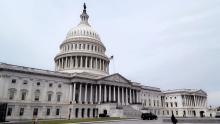
Fast, affordable Internet access for all.

With all the buzz around the prioritization of municipal and cooperative broadband networks in the American Jobs Plan unveiled by President Biden last week, let’s not forget about one leading voice in Congress calling for broadband for all.
Last year, with assistance from the House Rural Broadband Task Force he created, Rep. James Clyburn, D-SC, introduced the Affordable, Accessible Internet for All (AAIA) Act, a bold bill that proposed a $100 billion investment to build high-speed Internet infrastructure in unserved and underserved parts of the country.
Although the legislation stalled in the Mitch McConnell-led U.S. Senate prior to the 2020 election, it did set the Democratic agenda on broadband moving forward. Now, as the Biden Administration has settled into the White House and with Democrats in control of Congress, Clyburn has reintroduced a slightly slimmed down $94 billion AAIA, alongside companion legislation in the U.S. Senate sponsored by Sen. Amy Klobuchar, D-MN.
If it passes, the bill would be a game changer, as it goes beyond funding high-speed Internet infrastructure to attack the digital divide from essentially every angle. The bill includes funding and dedicated support to address barriers that prevent millions of Americans from having access to affordable, high-speed Internet connectivity. It backs measures that would encourage pricing transparency, promote Internet adoption and digital literacy initiatives, guarantee affordability, and protect the rights of workers who would build the networks.
While all of these measures are critical, one of the most important requirements included in the revamped legislation is for input from local, state and Tribal governments to be taken into account when determining what projects AAIA will fund.
Engaging local governments and local digital equity organizations in determining how billions of dollars in federal grants should be distributed may seem like second nature, yet in previous federal programs the views of these organizations, which understand the digital needs of their surrounding communities the most, have largely not been taken into consideration. Failing to consult with these entities in the past has resulted in funds not being used to their full potential.
We at ILSR believe that local institutions are best-equipped to confront the digital equity challenges facing their communities and that public sponsorship of private projects should be the single most important determining factor included in all future federal and state broadband grant programs.
Preference for Local Choice
The elevation of local preferences in how funding is allocated under AAIA is evident in the language and initiatives included throughout the bill.
Section 3203 of the bill makes local support a central component of investing in projects proposed by private Internet Service Providers (ISPs), requiring that state, local, and Tribal governments have a say in the private projects funded through AAIA. The legislation stipulates that in order for a private ISP to be eligible for funding, the ISP would be required to consult with any and all local or Tribal governments in the proposed project area. Private ISPs would have to demonstrate to the Assistant Secretary of Commerce for Communications and Information, the administrator of the NTIA, that there is sufficient local support for the proposed project:
In general, if an eligible project is carried out by an entity that is not a State or local government, or an agency or instrumentality of a State or local government or a Tribal Government or consortium of Tribal Governments, the project shall be publicly sponsored. A project shall be considered to be publicly sponsored if the obligor can demonstrate, to the satisfaction of the Assistant Secretary, that the project applicant has consulted with the State, local, or Tribal government in the area in which the project is located, or that is otherwise affected by the project, and that such government supports the proposal.
One of the bill’s six major sections is dedicated entirely to supporting community broadband initiatives. Section 4001 of AAIA would amend the 1996 Telecommunications Act to guarantee the right of local governments, public-private partnerships, and cooperatives to deliver Internet services. Overturning the laws in 18 states that erect barriers or outright prevent community broadband networks would be a big deal on its own, but the consideration AAIA takes for local initiatives doesn’t stop there.
Section 1203 of AAIA calls for the Assistant Secretary of NTIA to collaborate with community stakeholders and consult national, State, Tribal, and local organizations that conduct digital inclusion and digital literacy services to increase public engagement in data collection and analysis.
Preference for Open Access
Another significant component embedded in AAIA aims to create competition in the broadband market. The bill gives funding preference to projects that promise to deliver open access networks, a strategy sure to introduce competition in a market where millions of Americans are stuck with a monopoly provider (or relatively few high-priced, low-quality service options).
As we have advocated for on numerous occasions, publicly owned, open access networks can create a vibrant and innovative market for telecommunications services. Municipalities build the physical infrastructure (fiber optic lines, wireless access points, etc.) while independent ISPs operate in a competitive market using the same physical network. In this competitive marketplace, ISPs compete for customers and have incentives to innovate rather than simply locking out competitors with a de facto monopoly.
Beyond pushing for more community broadband and open-access networks, the AAIA also seeks to give local governments more time after securing funding to plan their projects, by allowing state and local governments to apply for funding in public-private partnerships prior to having selected a private partner. Public authorities would be able to submit applications for funding and then procure a private party to assist in operating planned networks.
The Opposition Ahead

Although Democrats control the White House and Congress, and a recent poll found that 71 percent of Americans support Biden’s American Jobs Plan, it’s not a forgone conclusion that AAIA will become law. The opposition is already lining up to either beat back the bill entirely or to at least substantially water it down.
The big cable and telephone companies have launched a smear campaign on at least two fronts. In the policy arena, they are asserting that basic Internet access offering speeds of 25/3 or 50/10 Megabits per second (Mbps) is "good enough" while they simultaneously drop millions of dollars on advertising campaigns on the coasts about their gigabit networks. There is also a coordinated campaign underway purporting to demonstrate why community solutions are bound to fail and money spent on municipal networks is a waste of tax-payer dollars.
As President Biden and Congress fine-tune their plans on infrastructure spending in the coming weeks and months, we expect cable and telco lobbyists will continue to try and peel off any Democrats they can with their enormous capacity to direct benefits to their champions and inflict pain on those trying to fix the broken market.
Stay tuned as we report on how AAIA works its way through Congress and whether the bill will get passed.
